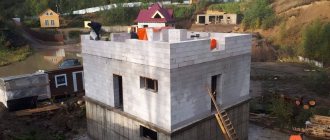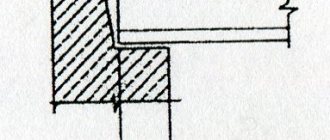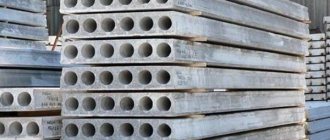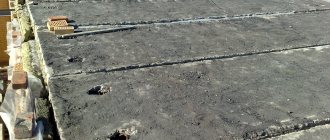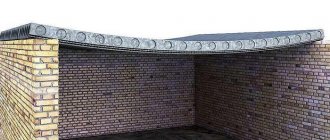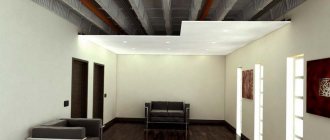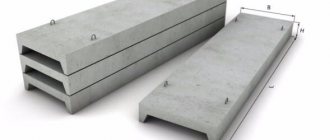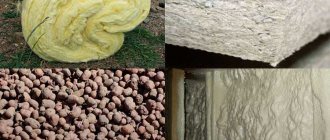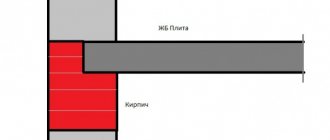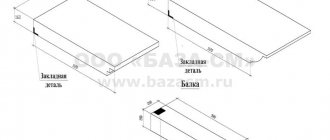Home |Blocks and floors |PB and PC floor slabs - what's the difference?
Date: March 13, 2017
Comments: 0
When carrying out activities related to the construction of residential buildings and industrial facilities, reliable reinforced concrete floors are used, installed between floors. At construction sites, similar-looking reinforced concrete products are stacked in stacks. It is difficult for the average person to find the difference between them. Only builders and designers can confidently distinguish PB floor slabs from externally similar PC slabs.
The products are used as connecting elements of building structures in the formation of interfloor sections of prefabricated and precast-monolithic buildings. Designers pay primary attention to the safety margin of floors, which affect the stability of the structure. In the construction of modern buildings, PC and PB floor slabs, which have much in common, are widely used. They are made of durable concrete, reinforced with prestressed reinforcement, and are resistant to fire and moisture. Air cavities effectively dampen noise and provide reliable sound and thermal insulation. However, there are differences.
A hollow-core floor slab (PC) is a flat rectangular concrete block
When dealing with construction issues, it is important to know how the products differ and what the technical characteristics are. Therefore, we will consider in detail the operational parameters of the products, and figure out what the difference is between them.
Varieties
Let's look at the features of the products used and labeling:
- PB floor slabs are manufactured using a formless method using specialized equipment using vibration compaction. The formation of products of the required length is ensured by cutting the concrete during the hardening process on a conveyor line with continuous movement of the concrete mass. The length into which the PB slab is cut depends on the customer’s requirements and is a maximum of 12 m.
- Products labeled PC are manufactured by filling metal formwork with reinforcing bars and mesh with concrete mortar. The molded frame is subjected to vibration compaction, heat treatment, and subsequent extraction of the finished product. The length does not exceed 7.2 m.
PC and PB boards have a significant difference due to the peculiarities of the manufacturing process cycle.
Currently, many types of hollow-core products are produced, which vary in the diameter of the voids and the shape of the slabs themselves
What is the difference between PC and PB boards?
PC and PB floor slabs are reinforced concrete products used in modern civil and industrial construction as load-bearing floors during the construction of interfloor sections, as well as other connecting structures. Both of these types of reinforced concrete products are quite similar in their purpose, but they also have significant differences.
The main difference between these types of reinforced concrete products is reflected in their markings and lies in the manufacturing technology. Thus, PC is a round-hollow slab, and PB is a formless slab. Let's take a closer look at both methods:
| PC slabs are manufactured as follows: the reinforcement is placed in a metal mold and concrete is poured. Then the metal mold undergoes a short vibration procedure on special equipment (vibrating table) to uniformly fill the metal mold with concrete. Next, the metal mold with concrete is placed in a steaming chamber, where it is subjected to steam treatment under temperature conditions for 6-8 hours. After this, the finished product is removed from the metal mold. | |
| Molding of PB products takes place on a heated metal floor. Products are reinforced with prestressed thin cables (less often with wire), that is, stretched along the entire length of the manufacturing site. A special molding machine passes over the molding site on rails, leaving behind a continuous ribbon of concrete. Then the resulting line of reinforced concrete is covered with a film (thermal insulating material), heated and cut into products of the required length. |
The difference between the PB slab and the PC slab also lies in the possibility of cutting the PB slab, if necessary, at an angle of 450, which makes these reinforced concrete slabs more convenient for the construction of structures. Such slabs have a wide range of loads from 400 to 1250 kgf/m2. The advantage of PC slabs (equipped with round voids) over PB is the possibility of organizing holes in them for conducting intra-house communications. The voids of the PB floor slabs (oval) are not suitable for making holes in them that were not originally provided.
The dimensions of PC floor slabs vary from 2.0 meters to 9 meters in length, and the width of hollow core floor slabs from 1.0 m. up to 1.5m. In the case of PB slabs, the technology provides for transverse cutting of the slab with a diamond saw at any angle, any length and width.
The external differences of PB slabs are a more aesthetic appearance, the absence of roughness, cracks, smoothness and strict geometric lines.
In the production process of PC and PB slabs, high-strength concrete and prestressed steel reinforcement are used. The air chambers present in the floor slabs of hollow-core PC and PB slabs help dampen excess vibrations, allowing for maximum sound and thermal insulation of the building to be achieved. Also, PC and PB reinforced concrete boards have excellent fire resistance and moisture resistance. Both types of reinforced concrete floor slabs occupy a leading place in modern construction.
You can buy hollow-core floor slabs by contacting. To place an order, it is enough to know the product labeling or the data on the width, height and length of the slab included in the design documentation.
Our employees will help you select the necessary floor slabs and calculate their cost, taking into account delivery to your construction site. To do this, you need to call our office by phone: +7; or send a request by email: [email protected]
Print
Characteristics of products marked with PB
PB floor slabs, produced by the method of permanent formation of a concrete mass without the use of formwork, are characterized by high technical indicators:
- increased noise insulation characteristics;
- ideal external surface;
- ability to withstand significant mechanical loads and shock impacts;
- significant margin of safety;
- possibility of use in different climatic zones;
- reduced weight;
- high thermal insulation properties;
- extended range of product lengths, due to the peculiarities of manufacturing technology;
- the presence, if necessary, of an oblique cut of the end surface;
- resistance to penetration of moisture into the depths of the concrete mass, causing corrosion.
Upon visual inspection of the end part, it is easy to see that the PB slab is reinforced with cables. The products are reinforced with durable steel reinforcement, providing increased strength properties. To understand how significantly the products differ from similar PC slabs, let’s consider the technical characteristics of the analogue.
The panels can be used on structures of any installation dimensions: the overall dimensions are so unified that they fit everywhere
Difference between PC and PB floor slabs
A PC floor slab is a product with round-shaped cavities inside the structure, which are used to cover the spans of residential and administrative buildings. Today, PC floor slabs are widely used in the construction of almost every building. Given the functions of this building element, it is important to comply with production standards. Unlike PB, it has stressed transverse and longitudinal reinforcement. The voids of the PC slab are provided for laying pipes and communications.
The PB floor slab is produced using improved technology; there are no surface tension cracks on it. This is a beam floor slab that has no transverse reinforcement. Despite its external similarity to PC, the PB plate has its own key features. It uses only longitudinal reinforcement, so such a slab can be cut lengthwise and obliquely at an angle of 45 degrees. for any size, which will be useful for non-standard solutions.
Marking features
Let's consider slabs PC 60.10-8At5 and PB2 63.15-8. The decoding of the first slab is as follows: PK 60.10-8At5 PK – serial number 60 – length (6 meters) 10 – width (1 meter) 8 – load (800 kgf/m2) At5 – reinforcement tension
Second plate: PB2 63.15-8 PB2 – serial number (220 cm height) 63 – length (6.3 meters) 15 – width (1.5 meters) 8 – load (800 kgf/m2)
Properties of products designated PC
Products with the PC index have the following technical indicators:
- The production time is reduced to 14 days, which, accordingly, increases the cost of products, but reduces construction time.
- Can be used in all types of structures.
- Reinforcement with stressed or ordinary steel rods.
- Vibration resistance and reliable sound insulation, allowing to dampen significant vibrations and noise.
- Third group of crack resistance.
- Moisture resistant.
- Resistant to high temperatures.
- Equipped with mounting lugs for easy movement. This distinguishes the slabs from PB, which do not have sling elements.
Let's take a closer look at the distinctive points. Let's figure out how significant the differences are from slabs of similar purposes.
Since hollow-core floor slabs are intended for standard construction, they are marked during manufacture
Main varieties
Before you buy floor slabs, you need to know exactly what type you need. In individual construction, the following products are most widespread:
PC is a round-hollow slab with a thickness of 220 mm, produced using formwork molding technology.
PB is a hollow-core slab with a thickness of 220 mm, which is manufactured using the formless method.
PPS - bench floor slab
PNO is a lightweight slab made using the formwork method.
Any model is produced in accordance with GOST. Each such product has its own symbols. How to understand them?
As an example, let's take a floor slab from our catalog - PB 22-12-8
The PB mark means formless molding. 22 dm – length, 12 dm – width, 8 kPa – maximum permissible load.
Advantages of formless products
PC and PB slabs have much in common, but there is a significant difference. The main advantages of formless floor slabs from those formed in frames are the following:
- improved quality of the external surface of the product. To ensure flatness, special equipment is used that operates continuously, forming a smooth surface. The products are easy to distinguish from PC slabs that have significant irregularities;
- clear geometric dimensions, ideal shape, facilitating the implementation of construction activities related to the installation of products;
- the use of advanced manufacturing technology with cable reinforcement, which eliminates the surface tension factor that causes cracks;
- the ability to manufacture products of various dimensions (2-12 m), ensuring accuracy up to 0.1 m;
- extended range of perceived forces, depending on the size of the products and amounting to 0.6-1.45 t/m²;
- the presence of prestressed reinforcement in the concrete mass (for any product dimensions);
- the ability to form the end part of the product at different angles;
- easy creation of communication holes in the concrete mass.
The PB slab requires a special rigging device to perform slinging. This difference creates certain inconveniences during transportation. This product differs from PCs equipped with mounting brackets.
Advantages of PB floor slabs
Formless reinforced concrete slabs have advantages over other building materials:
- Regardless of the dimensions, the panels are reinforced with tensioned cables. Thanks to this, the building material is able to withstand heavy loads - 600-1450 kg/m².
- Minimum tolerances that ensure accurate geometric dimensions and correct shape of the product. This greatly facilitates construction work, since identical slabs of the correct geometric shape are easier to install.
- To install the necessary communication systems in the building, you can easily make holes of the required diameter in the floor slabs, since they do not have a metal frame.
- Production technology without the use of formwork makes it possible to produce reinforced concrete slabs of different sizes. The step of changing the dimensions of the product is 10 cm, and the length can be from 2 to 12 m.
- The surface of the building materials is of high quality.
PB floor slabs have one drawback - there are some difficulties in the process of transporting and moving them, which cannot be done without the use of special rigging equipment. And products marked PC are initially equipped with special mounting lugs.
Despite the shortcomings, PB and PC floor panels are in demand in construction due to their good strength properties. The product brand for a construction project is established by professional builders or designers.
Still have questions? Call us, our consultants will help you choose the right floor slab by type and size.
. Construction is a plus!
Performance properties of PC boards
Panels marked PC, poured into stationary formwork, have the following performance characteristics:
- accelerated production cycle, which does not exceed two weeks from the moment of molding;
- expanded scope of application, allowing the use of products for various designs;
- the possibility of using steel rods in a stressed or unloaded state;
- vibration resistance, ensuring the integrity of concrete at an increased level of vibration;
- increased sound insulation, making it difficult for extraneous noise to penetrate into the room;
- resistance to cracking as a result of various types of mechanical influences;
- reduced hygroscopicity, due to which the reinforcement does not lose strength under the influence of corrosion processes;
- fire safety, ensuring the integrity of the concrete mass when exposed to open fire.
Products marked PC, unlike PB products, are equipped with mounting brackets that facilitate movement during transportation. The characteristics of the products have a lot in common, however, there are differences.
Floor slabs allow the construction of multi-apartment, multi-storey and individual residential buildings
Distinctive features of PB and PC boards
Looking at the production features, you can evaluate how PB floor slabs compare favorably with PC:
- The use of one type of wire and its more compact arrangement facilitates and speeds up production;
- higher grades increase the strength of the product;
- A more ergonomic arrangement of reinforcing elements can significantly speed up production, which means you can order slabs specifically for your needs and receive them in the shortest possible time.
- PB floor slabs can be cut in any required increments of 10 centimeters, while the length of PC slabs is determined by the availability of molds of a certain size from the manufacturer.
Types of reinforced concrete floor slabs
Reinforced concrete floor slabs are structures that are widely used in modern construction and are used for the construction of floors in buildings for various purposes.
Very high demands are placed on these products, because the safety and service life of the building as a whole depends on their quality. The concrete from which floor slabs are made can be light, heavy or dense silicate. The material, accordingly, determines the permissible loads and scope of application. And depending on this, the slabs are distinguished by thickness, diameter of the voids and number of sides for support. Below is the classification. 1. Hollow-core floor slabs
Hollow-core floor slabs
This type of product can be called universal, because its use is not limited by the type of structure. The main distinguishing feature of such floor slabs is the presence of voids located parallel to the length. They almost always have a round cross-section (although there are slabs with an oval cross-section, PG, for example). It is also typical to make recessed grooves along the side edges. The production of hollow-core floor slabs is clearly defined by GOST. The length and width of the slab are regulated. There are also certain requirements for reinforcement. It is possible to use only fittings of a certain class. And it must have an anti-corrosion coating. Hollow-core floor slabs have a wide range of applications and can be used in all types of structures (both residential and non-residential). To understand what a particular slab is intended for, just pay attention to its markings, which are usually applied to the side or top of the slab. These are groups of numbers and letters in which the first value indicates the type of slab, dimensions in decimeters, the second - the load-bearing capacity number or design load in kilopascals, the steel class of the reinforcement, the type of concrete and the third - additional parameters, if they are important. For example, there are hollow-core floor slabs (PB, PC, NV) with a height of 220 mm. Their marking will look like this: P 63-12-8, h=220mm, L=6270mm, B=1290mm, designed for a load of 800kg/m2.
1.1 Hollow-core slabs marked PB
Hollow-core slabs marked PB
PB slabs have overall dimensions: 120 mm width and 220 mm thickness. They require support on both sides and are used to cover large areas (warehouses, entertainment centers, garages, etc.). They are made only from heavy concrete. Their main advantages are the most accurate linear dimensions, as well as the presence of mounting loops, which greatly facilitates the installation process.
1.2. Hollow-core PC marking boards
Hollow-core slabs marked PC
PC slabs correspond to the following sizes: 100, 120, 150 mm in width, from 150 to 900 mm in length. The load that such slabs can withstand is from 6 to 12 kilopascals, not counting their own weight. Such slabs are produced from prestressed reinforced concrete raw materials by pouring into molds and subsequent vibration compaction with final heat treatment.
1.3 Hollow-core slabs marked NV, NVK, NVKU, 4NVK This type of building materials is made of prestressed concrete. Depending on the number of rows of reinforcement and the weight of the slab, there are four types: • NV - slabs with one row of reinforcement, length from 6000 to 7000 mm and design load from 300 to 2200 kgf/m2. • NVK - slabs with two rows of reinforcement, length from 6000 to 9000 mm and design load - from 300 to 2200 kgf/m2. • NVKU - slabs with two rows of reinforcement, length from 9000 to 12000 mm and design load from 300 to 1250 kgf/m2. • 4НВК - slabs with two rows of reinforcement, length from 6000 to 16200 mm and design load from 300 to 2500 kgf/m2. These types of slabs do not require mounting loops or embedded parts. They are installed using rope slings.
2. Lightweight floor slabs
Lightweight floor slabs
Lightweight hollow-core floor slabs (PNO, PBO, 3.1.PB) are also distinguished. They are smaller in height and weight compared to standard ones, but at the same time they can bend more under load. This type of slab is the most popular in the construction industry. This is due to the fact that the operating parameters of such slabs are comparatively higher than all other types. Such indicators are achieved due to the existence of a large number of cavities in the slab and a significantly smaller thickness. In addition, lightweight boards require lower production costs and fewer raw materials. Therefore, their cost is lower compared to standard ones. This means that among the products presented on the construction products market, lightweight slabs will have priority. As for the physical properties that such slabs possess, this can be called their main advantage. They have excellent sound and heat insulation characteristics, due to additional reinforcement they are characterized by high strength and lower weight. The main task in developing this type of slab was to reduce the load on the foundation of structures. And also the opportunity to increase the volume of buildings. This was achieved through the production of such slabs of smaller height. Their height is 160 mm (standard slabs are 220 mm). Thus, it can be said that lightweight slabs are superior to standard ones. In addition to the obvious advantages in their characteristics, according to expert estimates, it has been determined that construction using such slabs can be on average 15% more economical. The marking of the lightweight slab will be as follows: PBO 63-12-8, h=160mm, L=6280mm, B=1190mm, designed for a load of 800kg/m2. In addition, formless hollow-core floor slabs (PB) are also produced. These are structures that are manufactured on a special line using the bench method. The line content is cut into pieces using a diamond blade. Such slabs have a smooth surface and can be manufactured with or without mounting loops. The scope of application of such slabs is load-bearing structures of industrial and residential buildings made of bricks, blocks, monolithic and frame buildings. The height of the formless slabs is 220 mm and they are designed to be supported on both sides. They are significantly stronger than standard PC boards due to the use of stressed reinforcement during manufacturing. Their markings are as follows: PB 90-12-12, h=220mm, L = 9000mm, B = 1200mm, designed for a load of 1200 kg/m2.
Formless hollow-core floor slabs
3. Solid floor slabs Such slabs are also called monolithic. It’s easy to guess that, unlike hollow ones, they represent an integral structure. There are three types of solid slabs: • ribbed; • caisson; • beamless. And now in more detail:
3.1 Ribbed floor slabs
Ribbed Floor Slabs
Ribbed floor slabs get their name because they have ribs running in one or two directions on one side and a solid part on the other. The good thing about such structures is that they do not bend even under heavy loads. But they also have a drawback: the ceiling in buildings using such slabs is uneven, so they are mainly used in the construction of industrial buildings or attic floors. Like all other types of slabs, ribbed slabs are made with or without prestressing. The latter can be used exclusively under certain conditions: for multi-storey buildings with a distance between load-bearing structures of 6 m. Also, both light and heavy concrete are used in their production. All their characteristics are reflected in the marking, where there is a designation of the standard size (1P with support on the flanges of the crossbars, 2P - on the top of the crossbars), the design load of the slab, the type of steel for reinforcement and for concrete, the presence of holes. For example, 2 P1-3 AIIIvt.
3.2 Coffered floor slabs
Coffered floor slabs
Such slabs represent a grid of identical beams, the area between which is made of a thinner layer of concrete. Due to their appearance, they also received such names as often-beamed, waffle, often-ribbed floors. They are characterized by very high strength indicators and are mainly used in the construction of large industrial buildings, metro stations, large halls, etc.
3.3 Beamless floor slabs
Beamless floor slabs This type of structure looks like a flat slab without any holes inside or outside. During the construction process, beamless slabs must be supported not only by walls, but also by columns. The main advantage of this type of slab is that in the process of finishing the room there will be no additional costs for working with the ceiling. You can simply putty it and paint it. This may be due to the smooth structure of the slabs. All monolithic floor slabs are also characterized by the fact that they have no restrictions in length. The manufacturing process takes place right on site.
Characteristics
All technological characteristics for floor slabs were adopted taking into account GOST 9561-91. The greater number of positive qualities of floor slabs has allowed them to take a leading position among materials used in the construction of multi-storey buildings for private or industrial purposes. Very often, floor slabs can act as a supporting frame for a house.
The manufacturing process of the presented products involves the use of concrete, which is made from M300 and M400 cement. The numbers presented in the formula show the quality properties that, after receiving the finished product, will be inherent in it. M400 cement is characterized by a load of 400 kg per 1 m3. The material M300 is a derivative mixture from M400. Despite the fact that this material can withstand a slightly more modest load, it is still characterized by high ductility. As a result of this, the product does not break during deflections.
You can learn about the dimensions of the Assortment floor slabs from this article.
On the video - PC floor slabs: dimensions and GOST:
How to calculate a ribbed floor slab is described in this article.
In addition to concrete, reinforcement is used in the production of floor slabs. Thanks to reinforcement, it is possible to achieve high load-bearing capacity of concrete. Hardening occurs when using stainless steel of class A3 and A4. This material is characterized by high resistance to corrosion and temperature changes. In modern production of reinforced concrete structures, tension strengthening is used.
This is done this way:
- The reinforcement is tensioned in the mold, and then the reinforcing mesh is placed there.
- Thanks to it, the tension of the tensioned parts is distributed over the entire surface of the slab.
- After this, the form is filled with concrete, and when it hardens and becomes strong, the tension parts are cut off.
What dimensions of reinforced concrete floor slabs according to GOST can be found in this article.
Thanks to this strengthening option, it is possible to eliminate sagging of floor slabs, and it also becomes possible to withstand significant loads. Double reinforcement is installed at the ends of the product, with which it rests on the load-bearing walls. Thus, it is possible to prevent not only deformation under the pressure of its own mass, but also withstands pressure from the upper load-bearing structures.
The structure of any floor slab contains three parts:
- The upper one , on which the residential floor is concentrated. This includes flooring, screed and thermal insulation elements.
- The lower one , below which the living room is located, involves cladding the ceiling and hanging parts.
- Structural , which combines the upper and lower parts.
You can find out what dimensions according to GOST for hollow-core floor slabs here.
If we consider a hollow-core floor slab, it plays the role of a structural one. The facing elements that are involved in finishing the ceiling and floor constantly press on it, exerting static pressure. The finishing of floor and ceiling structures refers to all hanging parts, as well as those that can be installed.
How to make wooden I-beams with your own hands is indicated in the article.
There is also a dynamic load. It occurs as a result of the movement of objects along the surface of a plate. Moreover, here it is necessary to take into account not only the weight of the driving person, but also the weight of pets, which can be the most exotic.
Now it’s worth considering the distributed and precise type of pressure exerted. For example, a large punching bag is mounted to the ceiling. This is an example of a turned load. An example of a distributed load could be a suspended ceiling structure, whose base touches the suspensions in the ceiling at equal distances.
What dimensions of hollow core floor slabs can be found in this article.
These two types of load can affect the floors together, but then the calculation of the load will be complicated. For example, when installing a bathtub with a volume of 500 liters, two types of load must be taken into account. First of all, this is a distributed appearance, which is achieved due to the pressure of the filled bath on the support area between its legs. There is also a point load, which is achieved as a result of pressure from each leg separately.

